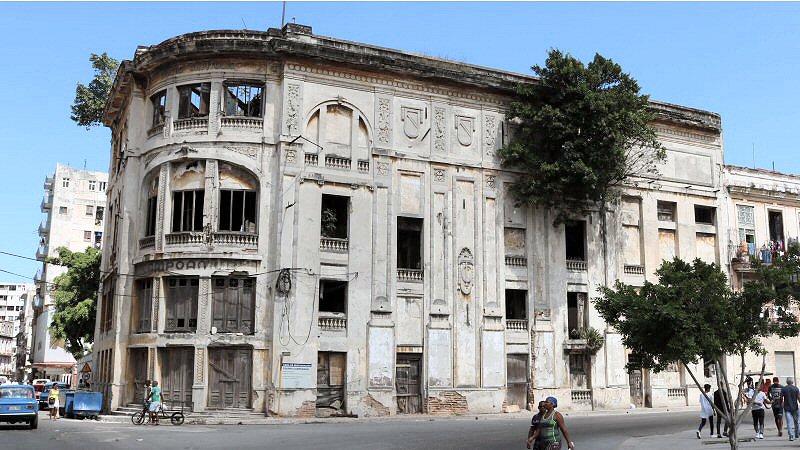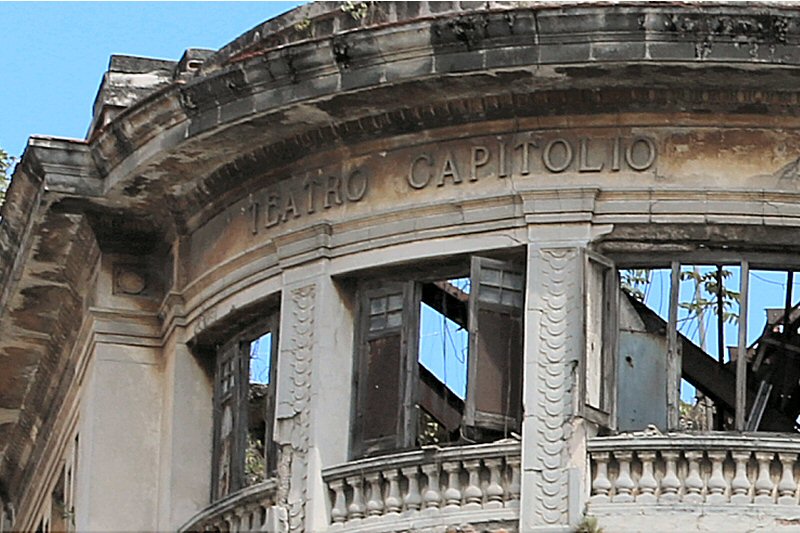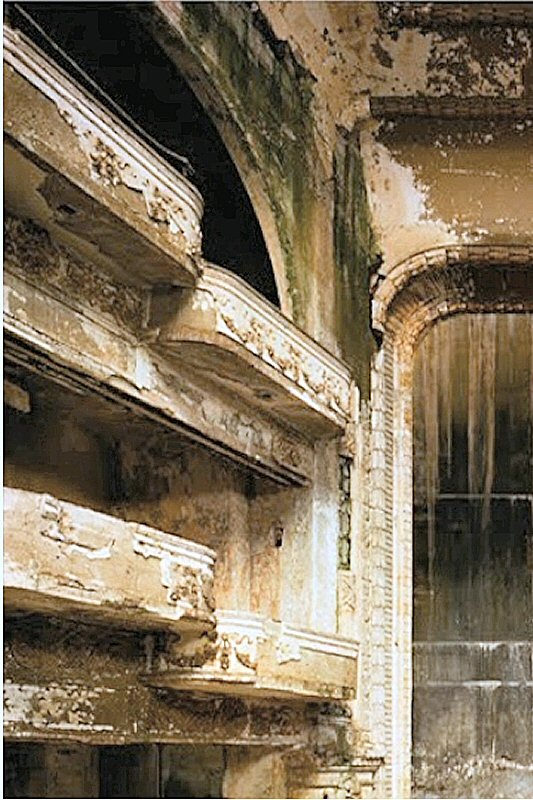
The Teatro Campoamor is located on the
Industria street, at the corner of the San José street, opposite
to the north facade of the Capitol. Currently, on the site you
will find only that what remained from the famous theater that
awaits an urgent restoration.
The Teatro Campoamor was built under
the name of Teatro Albisu in 1870. The Teatro Albisu,
located in the place of the current Centro Asturiano
(Austrian Center; Fine Arts Museum of Havana), is one of the
oldest theaters of the colonial time. It took its name from
its owner José Albisu. It had about 1.750 seats, but the
capacity could be increased up to 2.500 spectators. The
place was dedicated mostly to zarzuelas. Later, when it
became the property of José Azcue, its stage witnessed
thousands of zarzuelas, such as the La Verbena de la Paloma
(The Festival of Paloma), El Dominó Azul (The Blue Domino),
El Jugar con Fuego (The Play with Fire), La Bruja (The Ring)
and El Anillo de Hierro (The Iron Ring). The company was
renewing itself frequently and actors that were idols of the
public, were taking stage here.
In 1897 the Teatro Albisu was
accused because of the musics of the zarzuelas Cádiz (music
by Federico Chueca and Joaquín Valverde), and El Tambor de
Granaderos (The Drom of the Grenadiers; music by Ruperto
Chapí) that were staged in the theater. Towards the loss of
the colonies of Cuba and Philippines the music of the
marches of these zarzuelas were used as a second national
anthem by the furious Spanish fundamentals, and the reason
of the protests was that they were contributing to the
hostile actions against the fight of the Cubans for
independence. Ultimately in 1899, the theater was evacuated
by the order of the Creole Pedro Perfecto Pascual Lacoste y
Grave de Peralta, the first mayor of Havana after the
colonial time, appointed by the American Governor.
When the theater was reopened in the
first years of the 20th century, the spectators were divided
in groups according to the artists. The rivalry between the
artists led to the throw of the coins to the others by the
supporters during the performance. This rivalry continued
for years.
Those were the days of tenor Mateu
and tenor Casañas, José Piquer, Luis Escribá and Miguel
Villareal. Other stars of the
theater were Concha Martínez, Consuelo Baillo, Blanca
Matraz, Carlota Millanes, Paquita Calvo, María Conesa and
Lolita Font.
In 1918 the theater was destroyed by
a fire. Shortly after this unfortunate event another theater
was built in the same lot and inaugurated under the name of
Teatro Campoamor. The theater began to the new season with
the zarzuelas of the Mexican actress and singer María
Esperanza Bofill Ferrer. The Queen of the Operetta acquired
her international fame after the triumphs on the stage of
the Teatro Campoamor, and later built her own theater, the
Gran Teatro Esperanza Iris, in her country. On the other
hand, her company was the last great zarzuela company that
visited Havana. In the last days of the Teatro Campoamor the
place was destined also to film exhibitions. The Teatro
Campoamor was a rather popular place with an intense
program, but it had a short life, as it was destroyed by
another fire. Thus, it continued its activities in the new
building in the current localization. Subsequently, the
nearby cafés disappeared, such as the Casino that was a
meeting point for the journalists, comedians and the
bohemians.
The new theatre was inaugurated in
the coliseum of a cinematographic company in 1921, keeping
the name Teatro Compeamor, although it was named Teatro
Capitolio officially. Its owners were the businessmen Pablo
Santos and Jesús Artigas that were also the owners of the
Circus Popular Santos y Artigas, the most important circus
in Cuba. The theater was built at a cost of 300.000 pesos of
the time, but then it started to be used as a cinema. The
habaneros watched the first sound film The Jazz Singer just
4 months after the premiere in the US. For this purpose, the
Vitaphone audio system was installed in the building. That's
why at that time, when a person had a vigorous voice, it was
said to it: "Hey, what you have is a vitaphone?”.
For more than four decades, it
maintained to be one of the Havana’s leading venues for
cinema, theater, music and poetry. It was a place where the
singer Rita Montaner, the most popular performer of Cuba
from the 1920s until her death in 1958, exhilarated the
audience, starting with her first show here in 1924. The
Argentinean singer and actress Libertad Lamarque, the
Spanish copla singer, dancer and actress Lola Flores (María
Dolores Flores Ruiz), the Argentinean actress, singer and
dancer Magdelana Nile del Rio (stage name Imperio Argentina)
were among the popular artists, staged in Teatro Campoamor.
In 1930s and 1940s the
Afro-Cuban evenings were organized by Don
Fernando Ortíz, the Cuban essayist,
anthropologist, ethnomusicologist and scholar of Afro-Cuban
culture, and in 1936 the batá drums (double-headed
drum shaped like an hourglass with one end larger than the
other) of Pablo Roche were heard for
the first time on the stage on any of these evenings. The
Poetry Festival, directed by Juan Ramón Jiménez,
the Spanish poem that won Nobel price in Literature in 1956,
was another activity of the Teatro Campoamor that gathered
many exhilarated spectators. The vedettes in vaudevilles
like Angelita Castany and Blanquita Amaro, and the
music of the sainetes, composed by Rodrigo Prats, Alicio
Rico or Brienguer are unforgetable. The vedette is
the main female artist of a show derived from cabaret. The
sainete is a theatrical piece in one act, of a popular and
traditional character, represented in Spain during the
intermission or at the end of a performance. The
vaudeville is a light, often comic theatrical piece, born in
France, frequently combining pantomime, dialogue, dancing,
and song.
The Campoamor was
also a venue where important movies were run like Hamlet and
Roma, Città Aperta (Open City), as well as the Mexican films
and Argentine melodramas including the idol of tango Carlos
Gardel. It became a custom to combine sainetes or
vaudevilles with movies, so that the government
obliged the theater owners to offer films together with live
shows
The beautiful horseshoe-shaped
theatre of Havana, an emblem of Havana at night, was
destroyed by a fire in 1966. An attempt was made in 1987 to
restore the building, but it failed. Soon, the main entrance
of the damaged building was invaded by some people that
built their homes inside. Even a carpentry shop was opened
inside of the building. For years the place was used as
parking for bicycles, pedicabs and motorcycles. The building
in ruins suffered a collapse in 2012, so that only the
facade survived. Since that time the building has been
abandoned. The Cuban cultural jewel stands in vivid contrast
against the perfectly restored Capitol and the Gran Teatro
de la Habana Alicia Alonso nearby.



